Essential to human beings, salt, since antiquity, initiated barter, commerce, profit, conflicts and laws. Today, around 240 million tons of salt are yearly produced worldwide, including 39 million in Europe. In Poland, a stone’s throw from Krakow, the Wieliczka salt mine, a real journey into the bowels of the earth, will make you discover that salt is also available in the form of art works, scattered along a route between chapels, underground lakes and no less than twenty rooms located in the heart of the mine in operation since the 13th century. This historical site was registered by UNESCO on the first list of the World’s Heritage of Culture and Nature on September 8, 1978. The underground galleries, wells and lakes extend over 300 km with a depth ranging from 64 to 327 meters on 9 levels. After descending 360 steps in order to reach the first level, three fascinating hours teleport us into the harsh world of minors, both hard workers and self-taught artists. In this incredible maze, some spaces remind us of the setting of Fritz Lang’s film Metropolis and its lower town.

Michalowice Chamber, with fragment of wooden support and salt chandelier. Photo© K.HIBBS
Originally
In 3500 BC the inhabitants obtained their supplies from the springs and neighboring Wieliczka’s salt lakes . The salt was then obtained by evaporation over the fire of boiled brines. The Polish hunted and needed salt for food preservation. The first traces of such exploitation in the vicinity of Krakow date from the middle of the Neolithic (3500-2500 BC). The lakes were dug deeper and deeper as the needs grew until they reached the first lumps of rock salt. Wieliczka was nicknamed Magnum Sal in the Middle Ages (« Wielka Sól » in Polish which gave its name to the town). Salt was used as currency until the beginning of the 13th century. At that time, salt exploitation was still seasonal with an annual production ranging from 7,000 to 8,000 tonnes concentrated on the first level of the mine and its four wells. More specifically from the 13th century, a period of urban renaissance and demographic progression led to the growth of industries, the intensification of trade and the increase in the production of certain consumer products, including salt. This was a valuable food preservative and was also used for tanning hides and making alum and glass. In the 14th century, Casimir III, King of Poland, established the first mining laws by promulgating the Statute of the Krakow Saltworks (Zupy Krakowskie) in 1368.
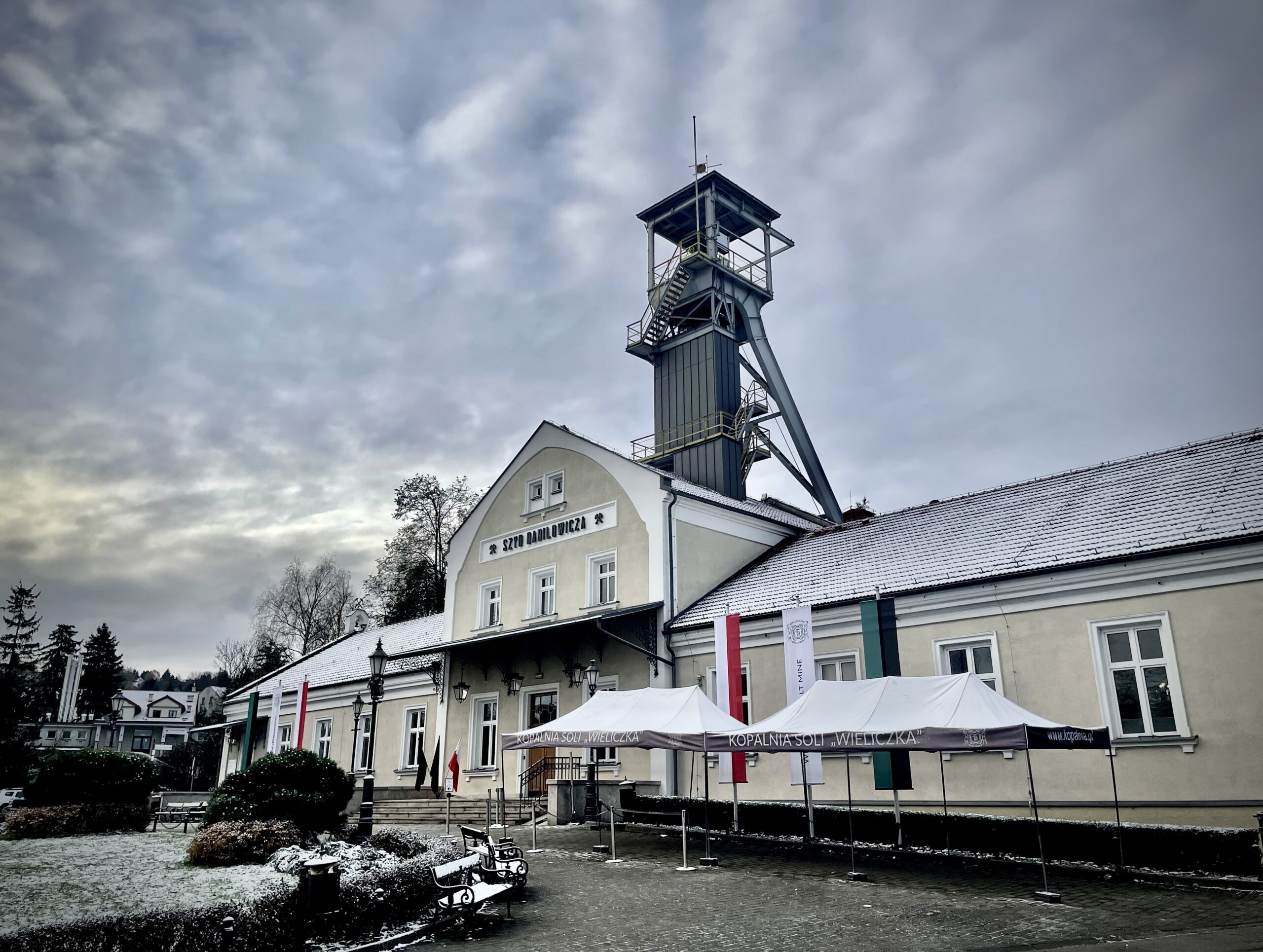
Main facade of the Wieliczka salt mine – Photo © K.HIBBS
Casimir III could not have done this without the income from salt mining, which represented up to 1/3 of the royal treasury’s income. These high profits allowed him, among other things, to create the Jagiellonian University in 1364 as the « Krakow Academy of Poland ». Salt constituted a valuable means of payment in the country’s economy and favored the exercise of power. In the 14th century the salt works provided a living for the court, coachmen, musicians, the apothecary and the king’s doctor. During the Sigismund dynasty, they provided the money necessary to remodel Wavel Castle. At the turn of the 16th century, Wieliczka salt mine became the largest mining spot operating in Europe. The deposit was exploited using traditional mining techniques such as digging galeries, extracting blocks of salt. Various wells made it possible to lift up water, which could cause ceiling collapse and floods in the mine. Between 1772 and 1918, the Austrian authorities managed these salt works, operating technical improvements and new working methods dedicated to the site. The extraction was done using gunpowder and steam engines, an underground railway line was created and an electric power station was installed. This moment of prosperity in the salt trade enriched the families who had a theater and small palaces erected in Wieliczka. In 1857, a railway line connected the mining town to Krakow. The mine became again a state property during the Polish independence on November 11, 1918. The exploitation of the rock salt site lasted more than 700 years, during which 26 wells and 9 million cubic meters of mining excavations were dug.

Salt sculpture representing the bust of King Casimir the Great made by the sculptor Wladyslaw Hapek (1968) – Photo © Katherine HIBBS
A story of men above all
The salt workers during the Jagiello dynasty were particularly protected by their different monarchs. There was no possible privilege without special authorization, workers could not be disturbed during their shifts. Visitoprs were not expected to visit the mine or receive free salt. It was impossible to count the number of miners before the 1960s when there were 2000 workers including 1000 underground miners in charge of dynamiting and transport. The other miners obtained the salt by evaporation and refined it in the open air. The profession was organized into different brotherhoods: the most experienced directed the work and dug, the carpenters installed timbering (larch wood supports for underground excavations) as the mine was dug to secure the site. In the 15th century, as the activity reached a large commercial level, carters and stable boys were hired to provide transport with horses. There were also blacksmiths and coopers. The salt was loaded into barrels placed on sleds used for horizontal transport. The Sielec Chamber, located 570 meters away from the starting point of the visit, presents a nice collection of salt transport devices. The last horse named Baska, having participated in the transport, left the mine in 2002. To ensure the conservation of the underground extraction sites and prevent their collapse, salt pillars and piles of wood were used until the beginning of the 20th century. The piles of wood, however, could be dangerous since an inadvertently knocked over oil lamp was enough to cause terrible fires, which was the case in December 1644. Between the 16th and 18th centuries the salt mine activity skyrocked in full swing.

illustration by James Ross Browne » Cutting off the salt » DR Courtesy of Mrs Malgorzata Piera
The Penitents, security guards in the mine
The presence of methane gas (equivalent to firedamp from coal mines) was justified by the decomposition over time of algae and organic matter coming from sea level. The miners used candles and gas and oil lamps to move in the dark, unable to smell the odorless and colorless gas. In 1645 the presence of methane ,which got in contact with a flame, caused an explosion and the mine burned during 8 months. Since water pumps did not exist at that time, the mine was entirely blocked. After this tragic episode, the most experienced old miners crawled on their knees, covered in wet rags, approaching long torches along the walls to burn the methane. Nicknamed “Penitents”, their risk-taking was very well remunerated. The minors were hired by the state. Most of them came from higher social classes and received a good salary.
A legend we still like to believe in
During the visit of the Wieliczka mine, the Janowice chamber awaits us at a depth of 63.8 meters on level I. Dug in a block of salt at the beginning of the 17th century, 6 salt statues, sculpted by the miner Mieczyslaw Kluzek , were placed there in 1967 to illustrate the legend of the polish prince Boleslas the Chaste and his bride Kinga (Cunegonde), daughter of Bela VI, king of Hungary. A lovely legend takes us to the marshy Puszta plains in Hungary where wild horses grazed. The king of these lands had a daughter named Kinga who got engaged to the Polish Boleslas and received from his hands a superb engagement ring. On the day of the wedding when she had to leave for Poland, King Bela seeing his daughter melancholy gifted her with one of his salt mines located in Marmarosz. Before leaving, the princess went to the salt mine and accidentally lost her ring there. Princess Kinga and her fiancé searched in vain for the ring and had to leave. Before arriving in Krakow, the team stopped in the village of Wieliczka to stock up on water. The villagers dug a well to quench the travelers’ thirst. The villagers dug tirelessly until they came across a huge block of salt which was brought to the surface. Inside, between the scattered pieces of salt, the princess’ ring shone brightly. Many historians have disputed this legend regarding the unexplained travel of the salt containing the ring from Hungary to Poland. According to the writer Adam Schröter (16th century) settlers from Hungary, very familiar with the methods of operating salt mines, settled near Krakow. It would seem quite likely that the polish ruler Boleslas, who had good connections with Hungary, brought in hungarian specialists to find salt mines there. Later in the 19th century another theory favored the version of a ring thrown by Princess Kinga into a well in Maramarosz in Hungary to seal her attachment to her native country. Hungarian miners who came to Poland would have returned it to the princess with the first block of salt discovered in the village of Bochnia located 35 km away from Wieliczka.

Chambre Janowice , » La Grande Légende », groupe de sculptures de sel par le mineur Mieczyslaw Kluzek -1967-Photo©K.HIBBS
Chapels dedicated to morning mass
Emptiness, darkness and fear have motivated generations of miners to find a true meaning in their daily lives. The mine took into account the thoughts, hard work and sometimes death of these men. From dawn, the miners went daily to mass in one of the mine chapels to get protected before sinking into the shaft’s black maw. St Antoine’s chapel (the holy protector of miners) is the oldest place of devotion in the mine. It was built between 1690 and 1710 in a baroque style. The second chapel, named Sainte-Croix, located on level II at a depth of 91 meters, was made accessible in the middle of the 19th century. The construction is framed by 2 rock salt columns whose capitals are decorated with plant motifs. Kneeling before a wooden crucified Christ are two salt statues of monks, eroded by time. It is certainly the inscriptions found in the underground galleries that witness the faith and fervor of Wieliczka’s miners. Within the chapel, sculptures and bas-reliefs follow one another depicting the life, death and resurrection of Christ. Talented contemporary miners have also left their works in this sacred place,
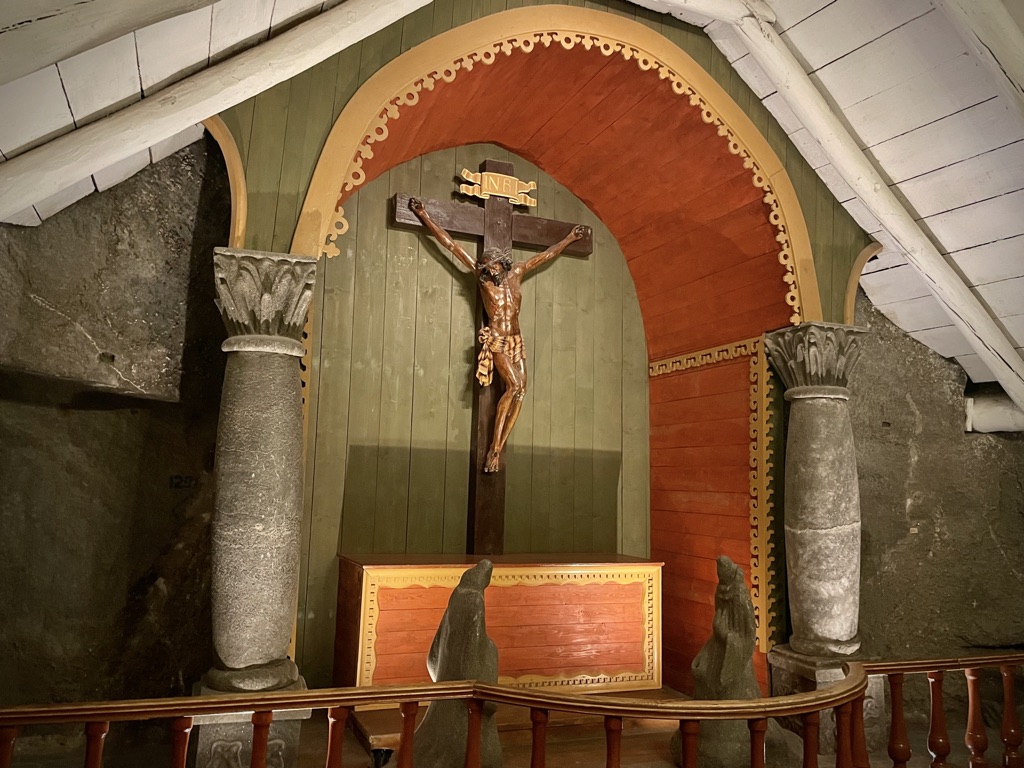
Chapelle de la Ste Croix, the crucified Christ in the altar, 19th-century wooden sculpture. Photo© K.HIBBS
The remarkable art works of the miners in Sainte Kinga’s chapel
This third chapel is certainly the most spectacular place sheltered within Wieliczka salt mine. This sanctuary founded in 1896 extends 54 meters long, 18 meters wide and 12 meters high on 2 levels. Remarkable sculptures were created there by the Markowski family of miners. Józef Markowski, born in 1860, created Sainte Kinga chapel. After starting to carve wood at the age of 16, he carved salt while working deep in the mine. He developed the bas-relief projects based on religious publications. Józef drew his charcoal sketches on walls. The young prodigy carved with miners’ tools used for salt blocks and manipulated a simple razor for details. The self-taught sculptor was helped by his brother Tomasz and other miners. Józef Markowski designed the main altar divided into 3 parts. In its central part there was originally an oil painting executed by the artist Ferdynand Olesinski (disciple of Jan Matejko) representing Sainte Kinga and a miner giving her a ring found in a block of salt. This painting was replaced in 1914 by a salt statue of the same sainte. The work of this great sculptor was continued until 1963 by Antoni Wyrodek.
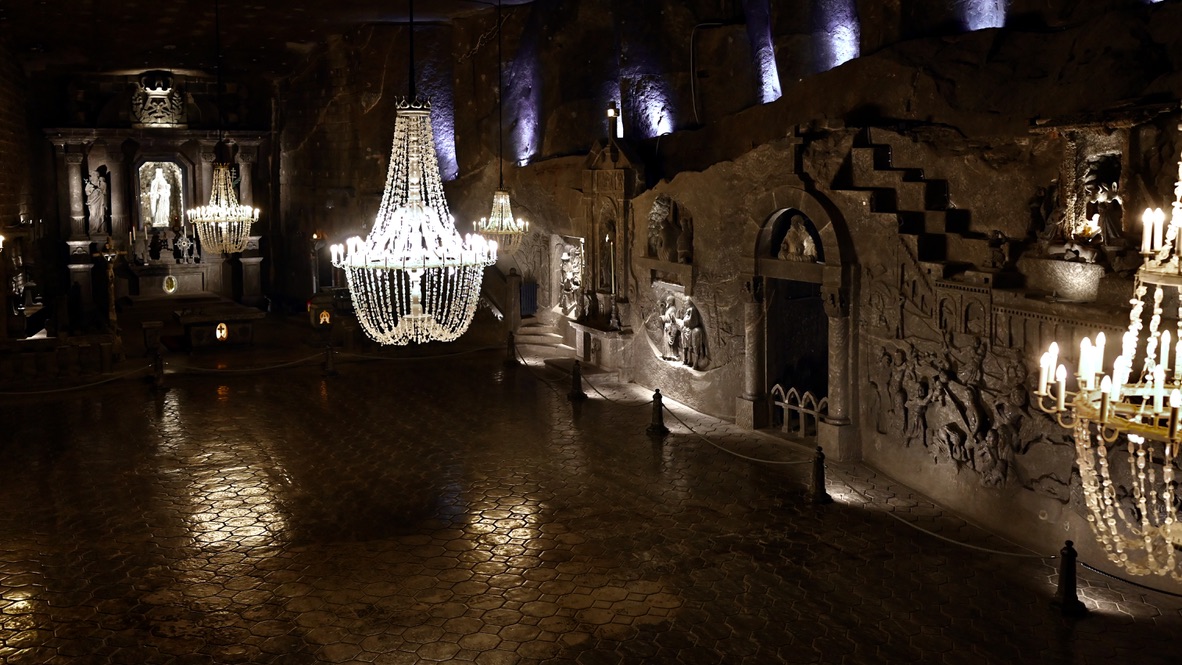
Sainte Kinga Chapel -Overview- Photo © K.HIBBS
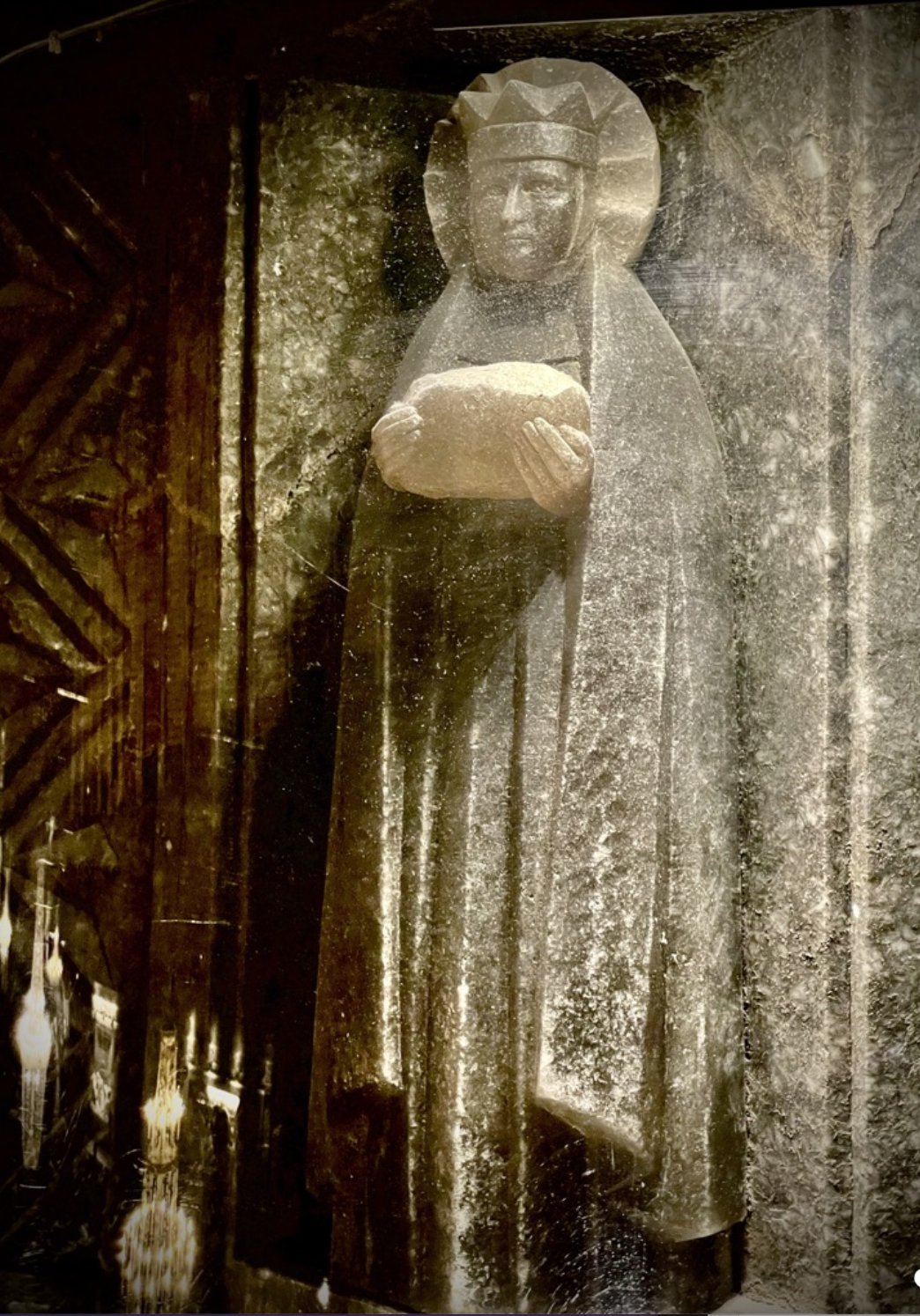
St. Kinga Chapel, fragment of the high altar and salt statue of St. Kinga by Józef Markowski, 1914. Photo © K.HIBBS
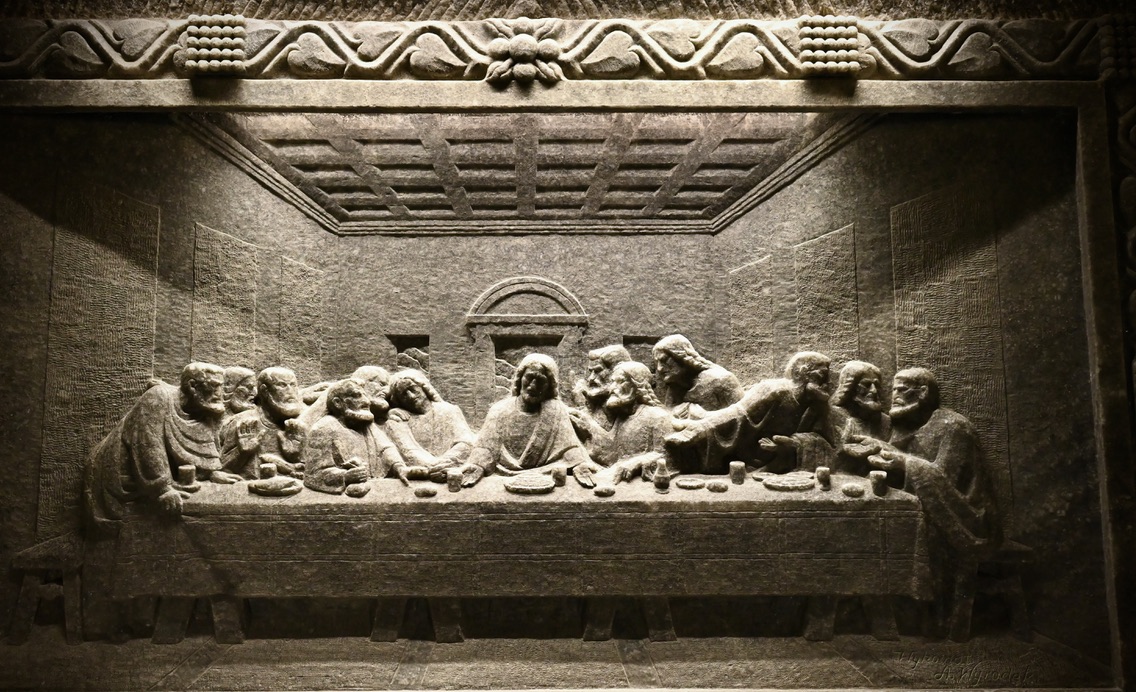
St. Kinga’s Chapel, salt bas-relief « The Last Supper » by Antoni Wyrodek after Leonardo da Vinci’s fresco -Photo © K.HIBBS
The Wieliczka salt mine, praised by poets, scientists and great travelers of the 19th century
The first visitors came in the Middle Ages. Among them was Nicolaus Copernicus, the famous polish astronomer who visited the Mine in the 15th century. A tribute was paid to him in 1973 with a sculpture by Wladyslaw Hapek to commemorate the 500th anniversary of his birth. The 16th century German poet Adam Schröter wrote the book Regni Poloniae Salinarum Vieliciensium Descriptio in 1565, a poem containing a number of descriptions of the mine, which made him famous. The author indicates the location of the Wieliczka mine, the different species of salt found there as well as the importance of the salt works for the state.The poet also mentions the origin of salt created by God in the form of salt, sulfur and Antimony. Adam Schröter describes the health properties of salt as « an admirable balm for inside and out. » Furthermore, according to the author, without salt “we cannot liquefy gold, it is the basis of the philosophical elixir”. Schröter’s writings include the works of the alchemist Paracelsus to his own poems. He also mentions the legend surrounding the marriage of Bolestas the Chaste, under whose reign the Salt Flats were discovered. In his work, Schröter gives the names of the different locations in the mine, giving details about the machines and the workers who work there. Johann Wolfgang Von Goethe, novelist, poet and scientist, was also interested in geology and went to the salt mine where a statue is dedicated to him.
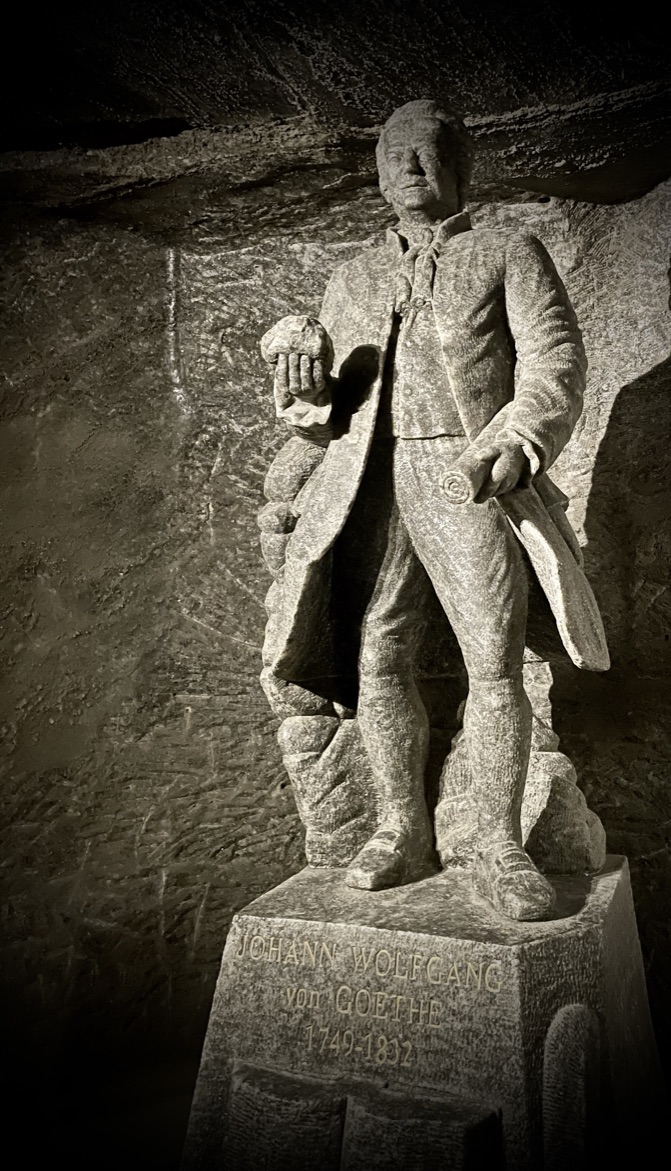
Statue of Johann Wolfgang Goethe created in 2001 by miner-sculptor Józef Piotr Kowalczyk© Photo K.HIBBS
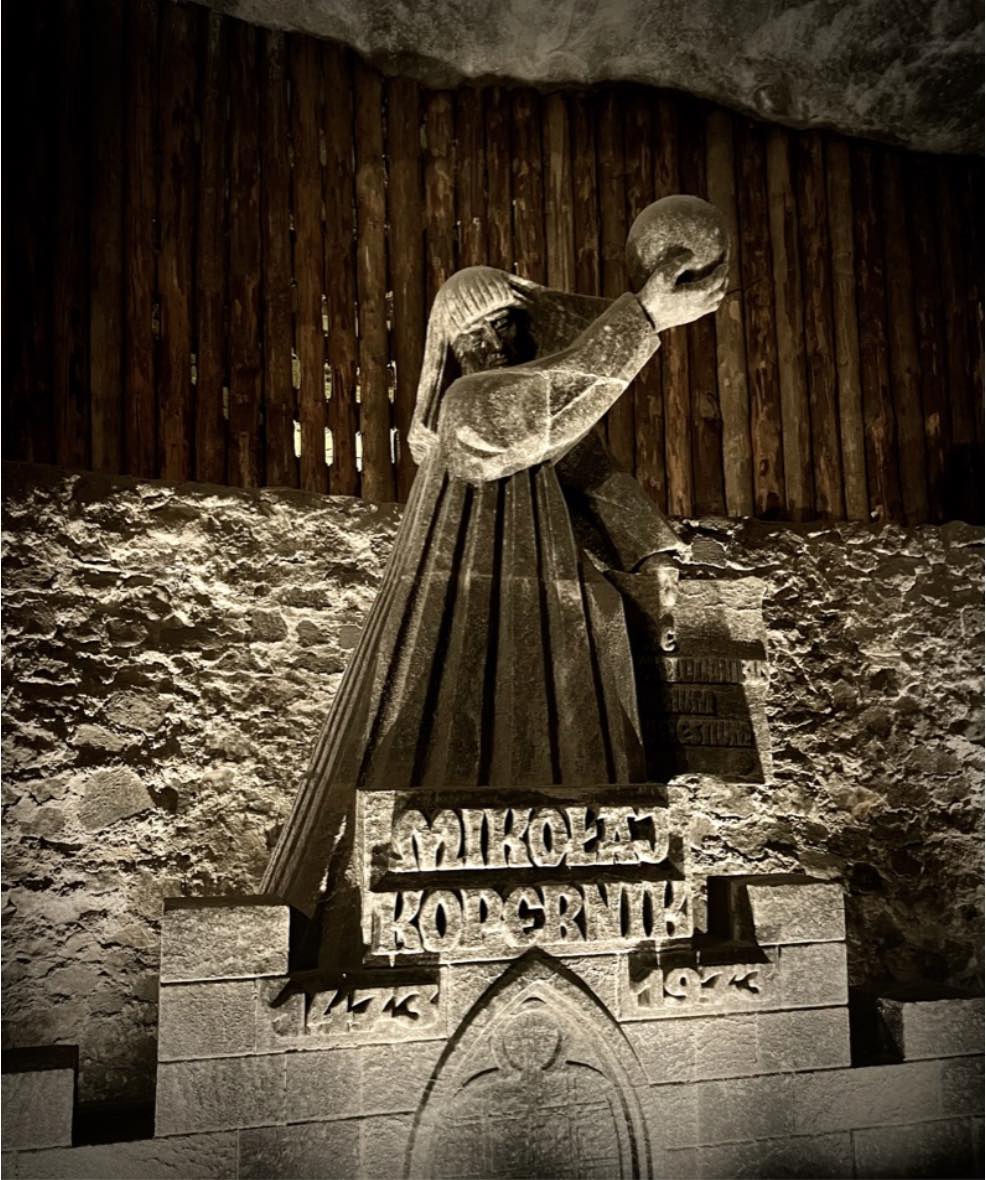
Nicolas Copernic, statue sculptée dans le sel par Wladyslaw Hapek (1973) Photo © K.HIBBS
Meeting with Malgorzata Piera, author of To Wieliczka by Stagecoach
Au Fil Des Lieux had the pleasure of conducting an interview with the Polish philologist and author Malgorzata Piera. This history enthusiast writer worked during 25 years at the Cracow Saltworks Museum in Wieliczka as an adjunct in the publications department. Her role consisted of the preparing editors revision and making correction of scientific articles of eminent authors of the museum (and other external experts in various areas of salt-related studies) which were published in the academic journal » Studies and Materials for the History of saltworks in Poland”. Apart of it M.Piera wrote articles for the GAZETA MUZEALNA and did research of historical and scientific documents related to the salt mine and the town of Wieliczka. Thanks to the accumulation of her numerous researches, Malgorzata Piera has published 2 works: An American tourist in the salt mine of Wieliczka ( Little-known story from the 19th century) and To Wieliczka by stagecoach or the memoirs of English-speaking travelers (18th/19th century).
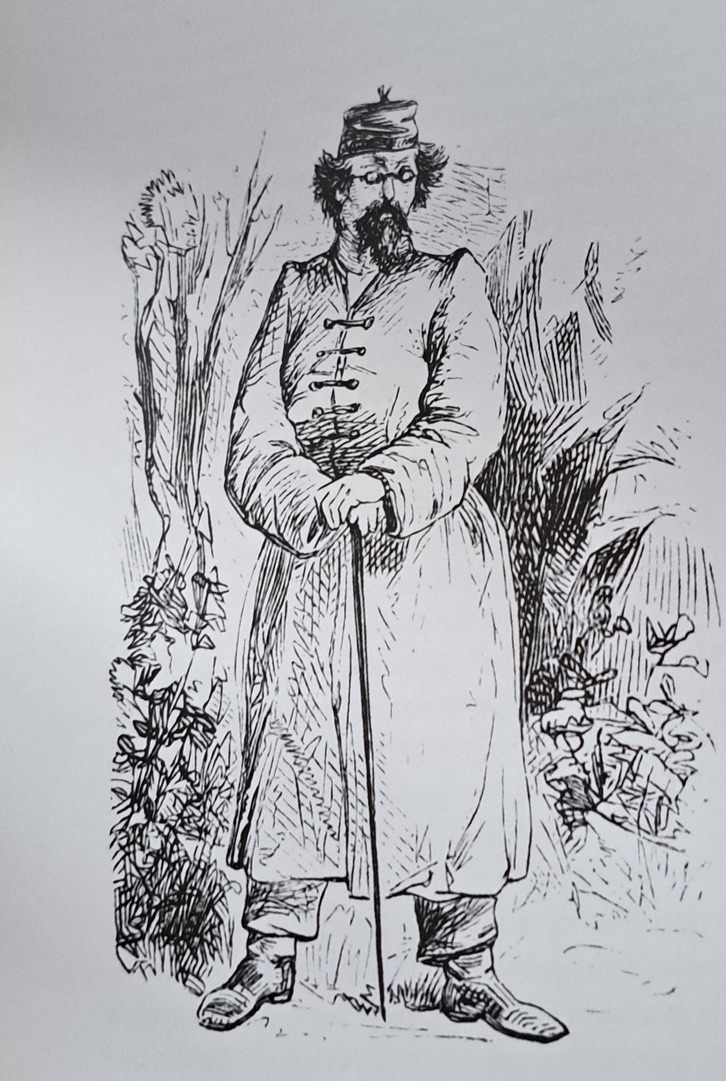
illustration by James Ross Browne » Visiting the mine » DR Courtesy of Mrs Malgorzata Piera
AFDL: What subject inspired you the most during this research?
« I was very impressed by the little-known links between foreign travelers and the Wieliczka salt mine. I discovered an early document dating from the 19th century concerning John Ross Browne, an American journalist, diplomat and traveler whose adventures and writings inspired Mark Twain. He came to Europe with his family and traveled to Poland to visit the Wieliczka mines. His wonderful descriptions accompanied by his own illustrations were published in 1866. This work was fascinating to read for anyone interested in travel stories or European history. His visit to Poland was the result of his desire to immerse himself in this « underground city. » John Ross Brown gives an impressive description of his descent into the bowels of the mine, attached to a rope. The world of mining appears as the mystical realm of darkness. His descriptions also focus on the equipment and the daily lives of miners. I realized that no one talks about it in our articles and museum books. So I translated his adventure and prepared a first book « An American in Wieliczka » on the journeys of foreigners who came to this mine. Later I discovered historical details and started writing Stagecoach Journeys to Wieliczka. Writing alone constituted a formidable leap into the past, especially since I am interested in the history of ordinary people, their lives and their emotions.
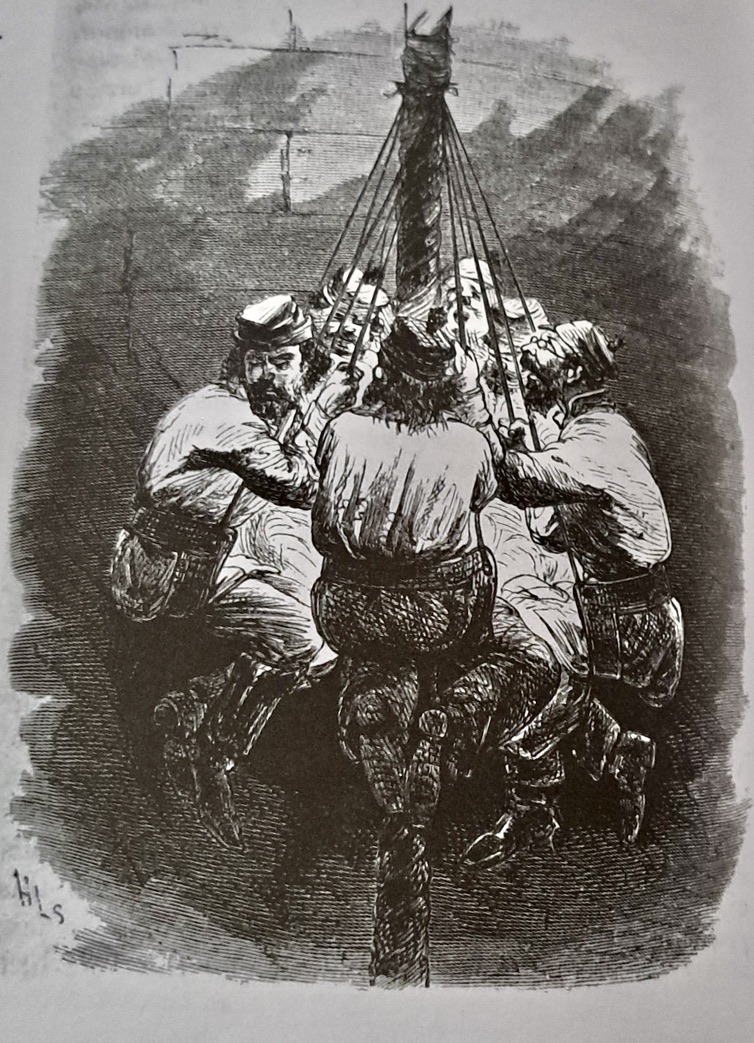
illustration by James Ross Browne » Descending to the salt mine » DR Courtesy of Mrs Malgorzata Piera
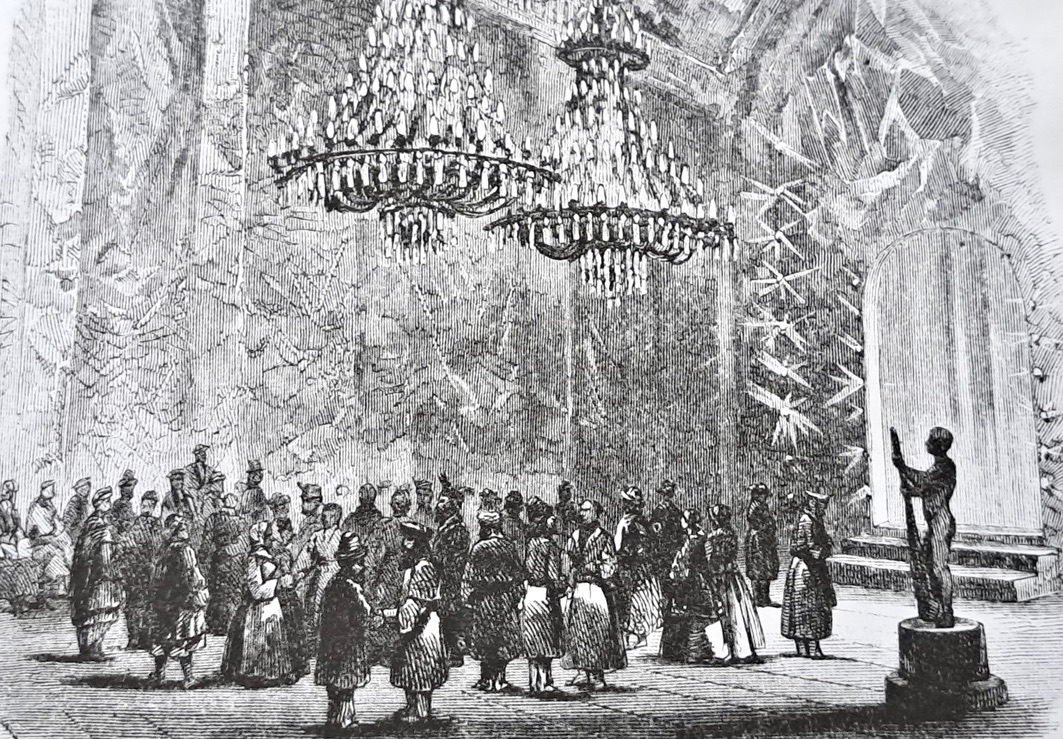
illustration by James Ross Browne » The bal room « DR Courtesy of Mrs Malgorzata Piera
AFDL: What mainly attracted visitors?
« They particularly admired the Letów ballroom, the underground lakes and described their descent to the bottom of the mine by sliding along a rope. These travelers came mainly to enjoy the underground spectacle shrouded in legends and mysteries. They had the opportunity to see the miners at work. The Wieliczka mine was popular worldwide in the 19th century. »
AFDL: Who were these travelers?
« The salt mine attracted many nobles and aristocrats, clergymen, politicians, journalists and famous artists. Unknown people also wanted to discover this unique place. In my book about stagecoach travelers, I mentioned scientists such as English Robert Townson and Jacques Peschier from Switzerland. I also cite the famous English globetrotter James Holman who was blind. He undertook a series of solo trips using a method of human echolocation. By October 1846 he had already visited all the continents. He came to Poland between the years 1822 and 1824. The English poet Eliza Craven Green moved to Wieliczka as did the American journalist James Walter Smith who wrote an article « The city of salt » which appeared in the Strand Magazine.
AFDL: Did France and Poland have a special bond regarding the mine?
« The dynastic links between the two countries meant that the salt mine was very frequently visited by the French in the 16th and 17th centuries. The most striking descriptions come to us from the poet Jean Regnard (1682), Gaspard de Tende and even by Jean Le Laboureur with his famous comparison of the mine to an Egyptian pyramid. In the 18th century, we also find a very popular quote on the mine written by Jean-Étienne de Guettard whose stay and studies in natural sciences in the Republic of Poland gave rise to major discoveries for the mine visited in the years 1760-1762. »
AFDL: Tell me about your current activities
« In addition to writing articles, I have been passionate about herbalism applied to beauty and well-being for 20 years. I have created workshops and I prepare cosmetics made in an artisanal way with oils and ointments herbal ».
The Cracow Saltworks Museum in Wieliczka
The Wieliczka Salt Mine is a different entity from the The Cracow Saltworks Museum in Wieliczka ; as a museum, it includes the Saltworks Museum and an underground exhibition on the third level of the mine, and is attributed to the Cracow Saltworks Museum in Wieliczka ( Muzeum Żup Krakowskich Wieliczka) which is a separate company from the Wieliczca Salt Mine. The underground exhibitions of the Cracow Saltworks Museum in Wieliczka were opened to visitors on September 30, 1966, presenting one of the most modern and original collections on the world of mining in Europe. Its creation is due to its founder and first director, Alfons Dlugsz, a graduate of the State School of Artistic Crafts in Berlin and the Academy of Fine Arts in Dresden. While in 1949 the salt mine administration decided to remove a certain number of wells, Alfons Dlugsz, realizing the heritage value of these wells, traveled with a miner tens of kilometers underground in search of old tools, crystals and fossils. Between 1958 and 1966 he established a large museum collection with all these treasures. Alfons Dlugsz also proved to be an excellent photographer and painter.

2097-13 2097/13/Zb.Spec. Collection Alfons Długosz, Fifteen photos from the series “Interiors of the mine”, Chamber in the salt mine, 50ties to 60tiesof the 20th century, Wieliczka, photo Alfons Długosz
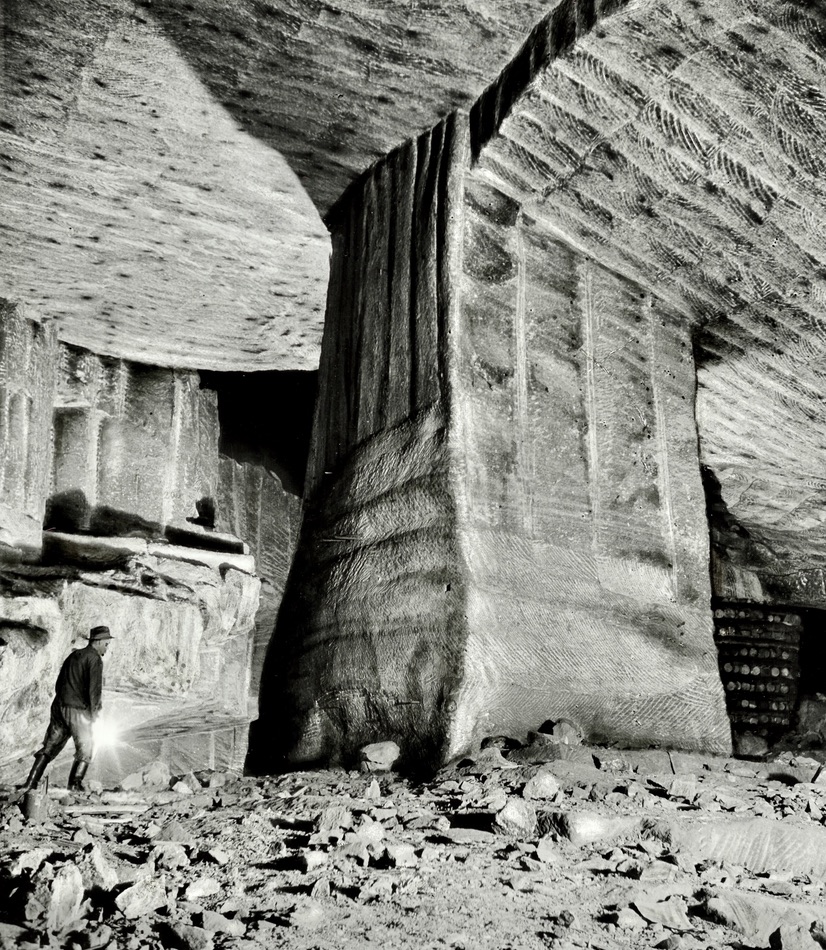
2096/2/Zb.Spec. Alfons Długosz, Five photos from the series “Interiors of the mine”, Chamber in the mine (central pillar in Margielnik chamber), 50ties to 60tiesof the 20th century, Wieliczka, photo Alfons Długosz
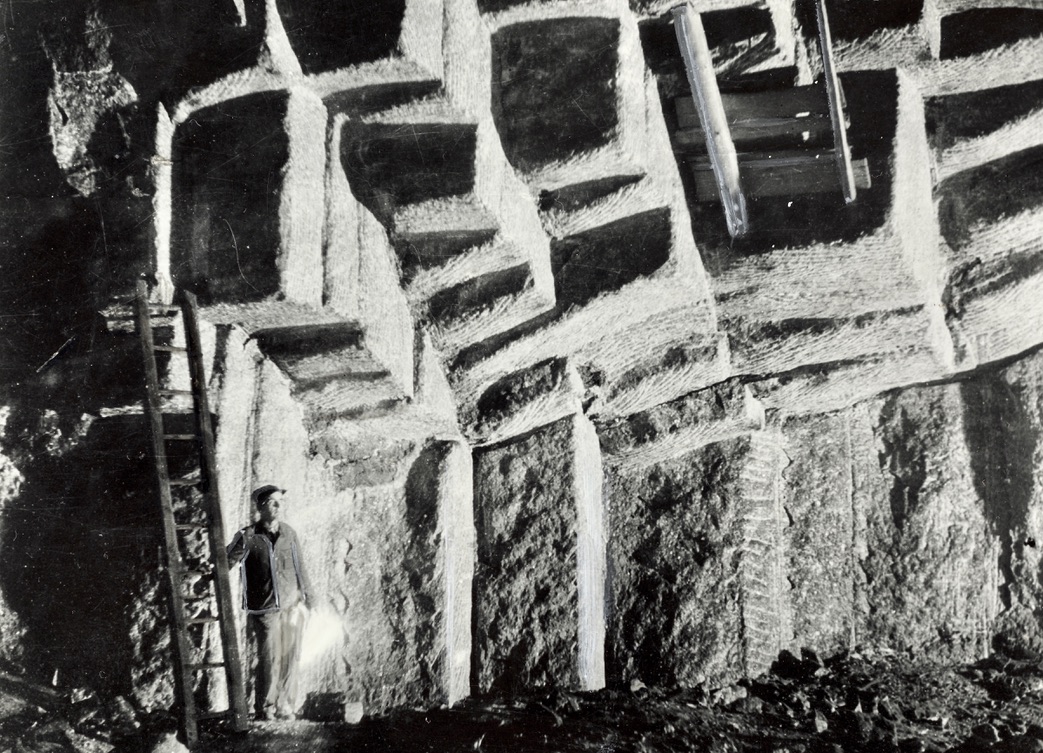
2097/1/Zb.Spec.Alfons Długosz, Fifteen photos from the series “Interiors of the mine”, Chamber in the mine, 50ties to 60tiesof the 20th century, Wieliczka, photo Alfons Długosz
*****
Visit the Wieliczka Salt Mine
www.minedeselwieliczka.fr
Ticket prices with visits in French and/or English here
——————–
How to get there
By plane
From Paris (Roissy CDG), direct flights by the company Easyjet,
count 90 euros for a one-way ticket in March.
https://www.easyjet.com/en
——————-
Accommodation in Krakow
1891 Garni Hotel****
https://garnihotel.pl/en/
———————
Access to Wieliczka
By commuter train — get on at Kraków Główny station and get off at Wieliczka Rynek Kopalnia station. From the station, you will arrive at the Mine on foot in a few minutes.
By bus 304 — get on at the Dworzec Główny Zachód stop not far from Galeria Krakowska. Get off at the Wieliczka Kopalnia Soli stop if you are going to Puits Daniłowicz or at the Wieliczka Rynek stop if you are going to Puis Regis. Buy an urban ticket that covers zones I and II.
————————
Information
Polish National Tourist Office in Paris
10 rue Saint-Augustin 75002 Paris
Tel. : 01 42 44 19 00
Fax: 01 42 97 52 25
e-mail: info.fr@pologne.travel
https://www.poland.travel/
———————–
Books to read
To Wielicza by Stagecoach
An American in Wieliczka by the author Malgorzata Piera.
Both books are available to order in English at the Polish bookstore in Paris – 123 Boulevard St Germain – 75006 Paris
Special Thanks to Ms. Dorota Cora – Muzeum Żup Krakowskich Wieliczka for the free use of original photographs from the Alfons Długosz collection and to Ms. Malgorzata Piera for the free use of illustrations by James Ross Browne.
All rights reserved for text and photos.




0 commentaires